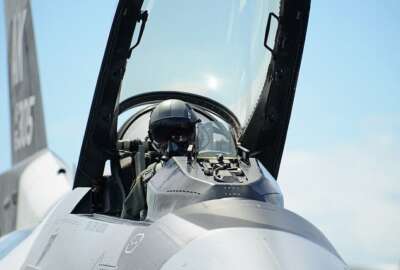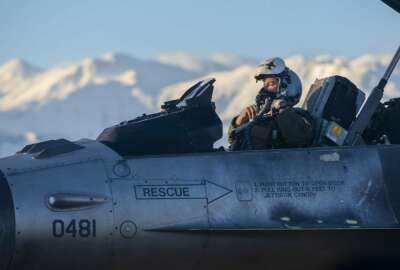
Oldies but goodies: Air Force looks to retirees to help pilot shortage
The Air Force wants retirees to take over some aviation related positions in the service.
Subscribe to Federal Drive’s daily audio interviews on iTunes or PodcastOne
Feeling bored in your retirement? The Air Force might have an answer for you. In an attempt to shore up its pilot shortage, the service is looking to retired pilots to fill the gap.
The Air Force is beginning its Voluntary Retired Return to Active Duty program to bring former pilots back to fill needed roles in the aviation realm.
Air Force Secretary Heather Wilson approved the program in July. The service is only looking for 25 retired pilots to join up at this point, and the tour length will last no longer than a year.
The former retirees won’t necessarily be flying, though they have the option to get in the planes and take off.
A number of non-flying staff positions need a pilot’s expertise. The Air Force hopes to fill those positions with retirees so pilots can stay in the air.
“We will match VRRAD participants primarily to stateside rated staffs that don’t require requalification in a weapon system, with emphasis on larger organizations like major command staffs,” VRRAD Rated Liaison Maj. Elizabeth Jarding of the Air Force’s Personnel Center said. “They’ll fill critical billets that would otherwise remain vacant due to the shortage of active-duty officers available to move out of operational flying assignments.”
That doesn’t mean they won’t deploy or get in a plane. The retirees will only deploy if they volunteer and will not be eligible for an aviation bonus.
Retirees must be under 60 to apply for the program and must have retired in the last five years.
The Air Force has been struggling with a pilot shortage. The most recent estimates clock the shortage at about 1,500 pilots and growing.
Lt. Gen. Darryl Roberson, the Air Education and Training Command director, said last month the Air Force needs to put out 1,600 a year to stay on track. Right now, it is producing 1,100 and wants to hit 1,400 in the next few years.
To deal with the problem, the Air Force has been meeting with private airlines to come up with a common solution.
“The chief’s big push is this is a national crisis,” said Brig. Gen. Michael Koscheski, director of the Air Force Aircrew Crisis Task Force. “+The airline industry is looking to double globally over the next 20 years, so this is a long-term growth in terms of the civilian market. They are short on pilots. It’s sort of a pipeline or cascading effect because the major airlines need more pilots, they are taking pilots from the regionals quickly and then the regionals are getting them from your civilian flying schools and they are struggling to keep up. We need to build a sustainable long-term model, where we have a larger pool of pilots nationally to pull from,”
Latest Air Force News
The Air Force is considering options like a national pilot training academy funded by airlines and the military to work on the shortage problem.
“Some of the near-term things are looking at when we have Guard and Reserve pilots. A lot of them work for the airlines and work part time for us. We want to look at ways to create win-win situations for both the airline industry and get maximum use of those pilots for what we need in the military. That’s a near-term thing we can do quickly,” Koscheski said. “In more of the longer term piece would be looking at a national training academy or public-private partnership with pilot schools, and then once we create a sustainable pipeline of civilian pilots, then look to have military pilots potentially co-trained with civilian pilots so we have an overall larger pool of pilots for a lower cost for everyone.”
Pilots aren’t the only place the Air Force is hurting. Maintainers are in an even bigger deficit for the Air Force. The service has been forced to bring on private contractors to fix and maintain planes and other craft.
The Air Force is struggling to keep its pilots in the service too.
The trouble comes when pilots are up for reenlistment.
Military pilots have training and hours required to qualify to fly for the major airlines without having to work for smaller regional airlines first.
“Because major airlines work on a seniority system, the best opportunity for salary growth in the major airlines occurs for military pilots leaving after their initial service obligation,” a July 2016 RAND report stated. Another factor that is appealing to military pilots is the Federal Aviation Administration increased the mandatory retirement age for pilots from 60 to 65 in 2007, giving pilots longer to cash in on their talents.
The RAND study states commercial airline pay has rebounded to mid-1990s peak salaries of $200,000.
Meanwhile, the Air Force can only offer a comparatively meager reenlistment bonus. The Air Force convinced Congress to increase the bonus to $35,000 this year. The Air Force also changed its reenlistment structure so pilots can reenlist for up to 13 years with the bonus pay guaranteed.
Copyright © 2024 Federal News Network. All rights reserved. This website is not intended for users located within the European Economic Area.
Scott Maucione is a defense reporter for Federal News Network and reports on human capital, workforce and the Defense Department at-large.
Follow @smaucioneWFED




